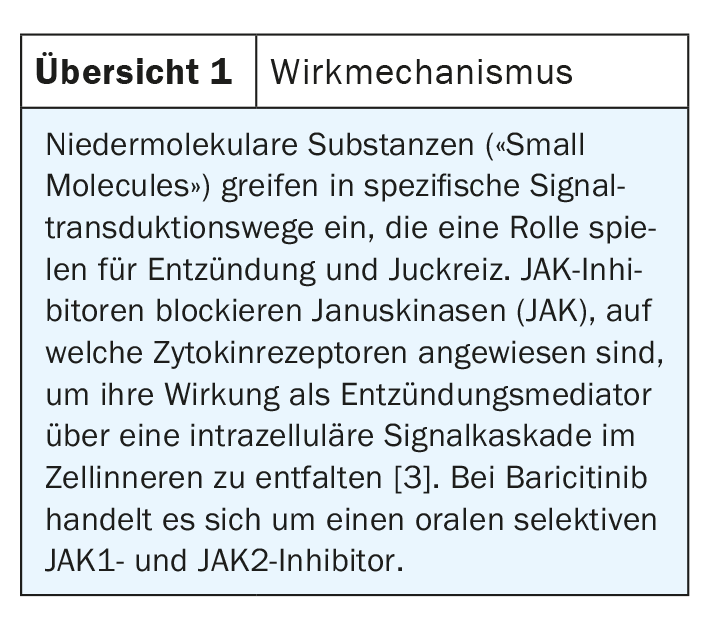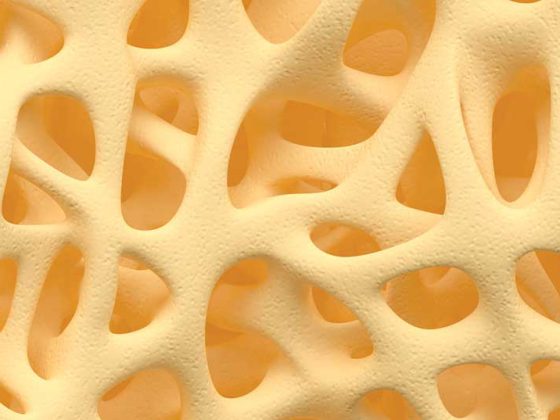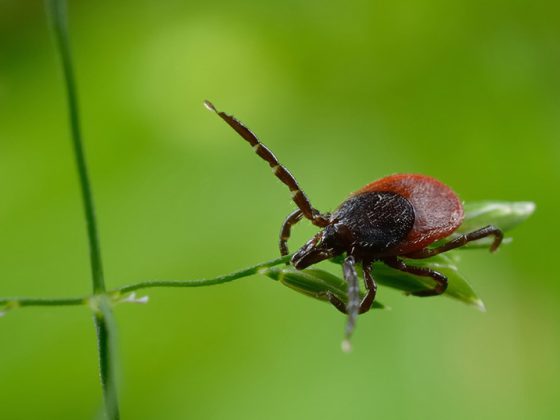The use of small molecule drugs for the treatment of atopic dermatitis has been investigated for some time. With the approval of the Janus kinase (JAK) inhibitor baricitinib, a new oral treatment alternative is now available for patients with moderate to severe atopic dermatitis.
Swissmedic granted marketing authorization to the Janus kinase (JAK) inhibitor baricitinib (Olumiant®) in February 2021 for the treatment of adult patients with moderate to severe atopic dermatitis. This is the first oral JAK inhibitor available in Switzerland for the treatment of atopic dermatitis [1] (box). Atopic dermatitis is one of the most common chronic inflammatory skin diseases and is associated with a significantly reduced quality of life, particularly in severe cases [2]. Comorbidities are common: itching can lead to sleep disturbances and the risk for depression and anxiety disorders is greatly increased compared to skin healthy individuals [4].

Rapid relief of itching and effective reduction of skin lesions
The BREEZE-AD7 trial evaluated efficacy and tolerability of baricitinib in combination with topical corticosteroids (TCS) of light or moderate class [6]. Already after four weeks, a significantly higher proportion of the group treated with baricitinib 4 mg and TCS showed a reduction of itch by ≥4 points on the pruritus NRS, corresponding to a clinically relevant relief (p<0.001) [6]. At week 16, 44% of patients receiving the standard dose of baricitinib and TCS achieved clinically relevant relief of pruritus, more than twice the proportion receiving placebo and TCS (p<0.001) [6]. Visible eczematous lesions in particular can be very distressing for patients with atopic dermatitis. In a survey of patients with severe atopic dermatitis in 8 countries, 82% reported that they were concerned about their appearance [3]. In the BREEZE-AD7 study, baricitinib also proved highly effective in terms of EASI75 response, which corresponds to a clearly visible relief of skin symptoms. At week 16, 48% of patients achieved an EASI75 response with baricitinib and TCS, more than twice as many as with placebo and TCS (p<0.001) [6].
Patient-friendly dosage form and good tolerability
Baricitinib is very easy to use: one tablet daily, regardless of meals or time of day. Since elimination is predominantly renal, there are few clinically relevant drug-drug interactions. Moreover, thanks to a short half-life, baricitinib is well controllable and can be adjusted to a dose of 2 mg if necessary [1]. Comprehensive data on the safety and tolerability of baricitinib in atopic dermatitis are available from a pooled safety analysis of 8 randomized clinical trials involving 2531 patients and 2247 patient-years [7]. This showed an incidence of serious infections, opportunistic infections, and conjunctival complications comparable to placebo. The most common adverse reactions reported were nasopharyngitis and headache, as well as elevation of creatine phosphokinases and diarrhea. However, these did not usually lead to treatment discontinuation [7]. Even in the rheumatoid arthritis indication, where baricitinib has been used for some time, the favorable safety profile of baricitinib observed in clinical trials for the treatment of RA proved to be consistent for up to 8.4 years, according to the results of a recent integrated safety analysis [5].
Source: Eli Lilly
Literature:
- Professional information Olumiant®, www.swissmedicinfo.ch, (last accessed 08.04.2021)
- Silverberg JI, et al: Ann Allergy Asthma Immunol 2018; 12(3): 340-347 .
- Guttman-Yassky E, et al: J Am Acad Dermatol. 2019; 80: 913-921.e9.
- Ronnstad ATM, et al: JAAD 2018; 79: 448-456.
- Genovese MD, et al: Ann Rheum Dis 2020; 79 (Suppl. 1): 638, Abstract: FRI0123
- Reich K, et al: JAMA Dermatol 2020; 156(12): 1333-1343.
- Bieber T, et al: J Eur Acad Dermatol Venereol 2020; doi: 10.1111/jdv.16948
DERMATOLOGY PRACTICE 2021; 31(2): 30













